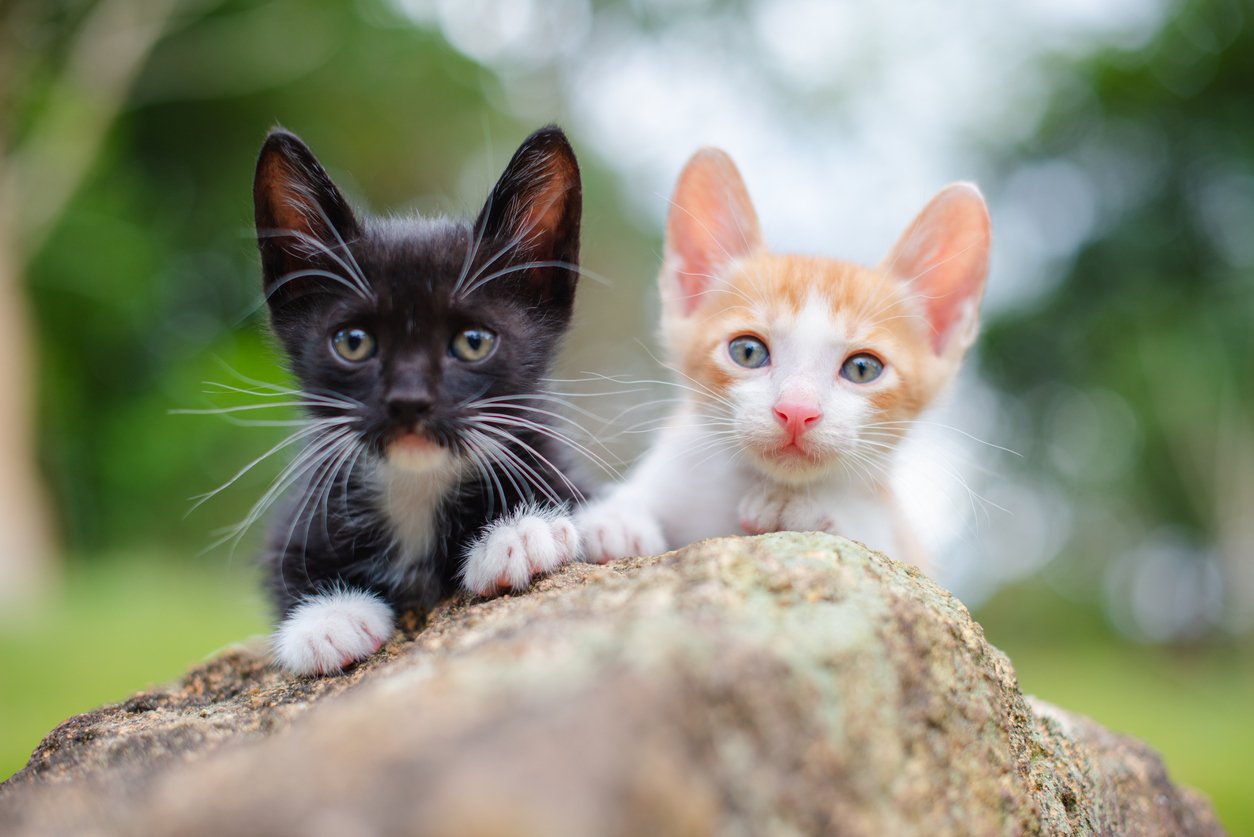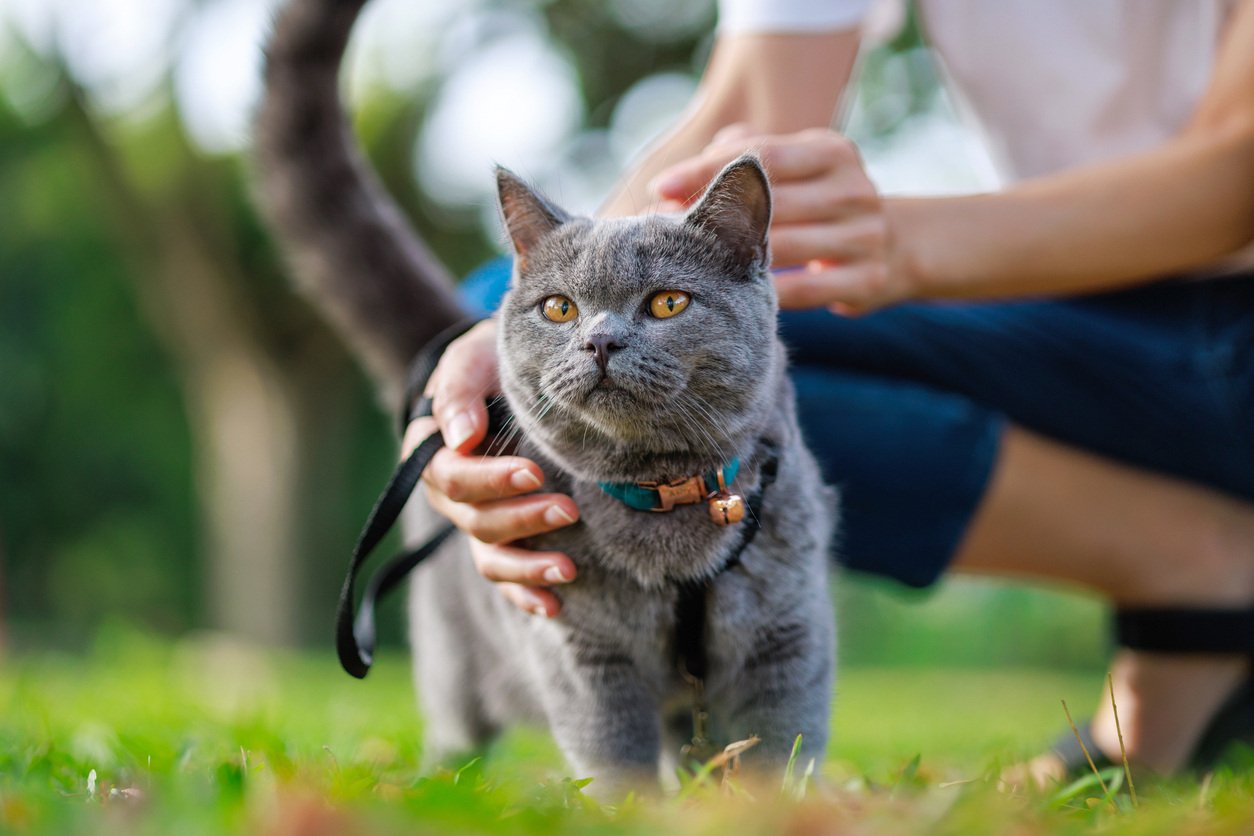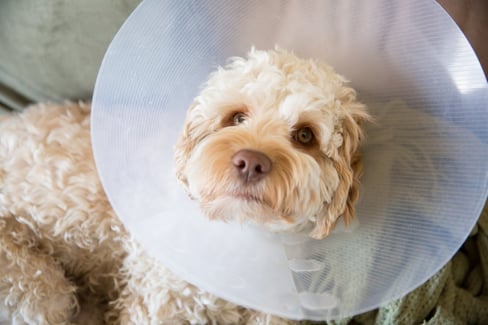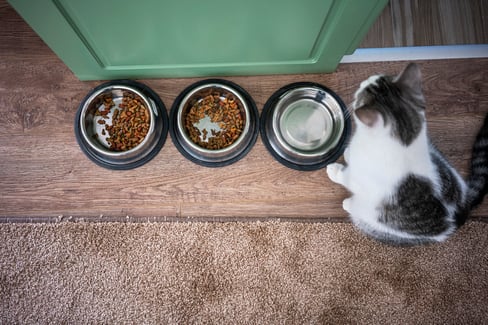Table of Contents
You can’t deny there’s something undeniably cute about kittens. Tiny noses, tiny toes, and the cutest high-pitched “meows” make these baby felines absolutely adorable.
As much as we love our cuddly kittens, the idea of our cats having kittens is often not part of our plans. The topics of cat spay and neuter planning should be on your mind in your early days as a kitten owner.
Female cats go into heat every two to three weeks from spring to fall, and can become pregnant up to five times per year. With an average of four kittens per litter, your cat could mother over 20 kittens in a single year; that’s a whole lot of kittens!
“Spaying” is the term commonly used by pet owners to refer to an ovariohysterectomy. An ovariohysterectomy is a surgical procedure where a cat’s uterus and ovaries are removed to sterilize a cat and prevent reproduction. While preventing the abundance of furry offspring is the primary goal of a cat spay, there are several other health benefits to spaying cats, which we will discuss in this article.
So, if you’re thinking of becoming a cat owner or have welcomed a new kitten to your family, be sure to prepare for a cat spay or neuter in the upcoming months, along with the essentials of cat care.
When to Spay a Cat: Best Age and Timing
Cats are very fertile creatures. While you may consider your fur baby still a kitten, female cats go into heat and become pregnant as early as four months of age.
What does it mean when a cat is in heat? “Heat” refers to the time in a female cat’s life when she is fertile and can become pregnant. Once a cat has her first heat, she will continue to go into heat every year from around February to October. Each heat cycle lasts 2-3 weeks.
The six most prominent signs a cat is in heat include:
- Strong affection towards humans and other cats.
- Loud howling/ meowing.
- Arching back and flicking the tail.
- Frequent urination.
- Decreased appetite.
- Restless behaviour.
There are four distinct phases of a cat's heat cycle: anestrous, proestrous, estrous, and interestrus.
Refer to the chart below for an overview of cat heat cycles before cat spay surgery.
|
Cat Heat Cycle Stage |
Description |
|
Anestrous |
|
|
Proestrous |
|
|
Estrous |
|
|
Interestrus |
|
If a cat does mate and release eggs, but no eggs are fertilized, they will enter a stage called metestrus, lasting 30-40 days. Fertilization of the eggs will result in a pregnancy.
Unlike humans, who endure over a 9-month pregnancy, a cat’s gestation period is on
average 65 days, or approximately nine weeks. This means that a female cat can have 20 or more kittens per year. If you compound that number by her offspring, the amount of kittens brought into the world can be extremely high. Not spaying a cat can potentially result in thousands of new cats introduced to an area within a short time, which is why most municipalities and rescue organizations have some form of trap-neuter-release program in an effort to control community cat populations.
Neutering male cats is often an easier and more straightforward procedure that can be done without anesthesia versus a spay, which is a full-blown surgery, so male cats within a community are typically focused on for the trap-neuter-release programs for this reason (we dicsuss more differences between spay and neuter surgeries later on in the article).
When we talk about cat spay procedures, it’s best to be proactive and schedule the surgery before your cat’s first heat.
How Old to Spay a Cat?
As a new cat or kitten owner, you’re likely wondering, “When can you spay a cat”?
Many animal shelters offer and encourage early cat spay and neuter programs when kittens are eight weeks old..
Shelters offer early cat spay programs for several reasons:
- Reduced cost to new kitten owners
- Convenience for pet owners
- Decrease shelter populations
- Minimize health risks
Most veterinarians recommend spaying your cat before their first heat cycle, at around four to five months of age. While cat spay surgery can be done anytime in your adult cat’s life, there are several benefits to opting for an early cat spay procedure.
Refer to the chart below for the pros and cons of early cat spay surgery.
|
Pros of Early Cat Spay |
Cons of Early Cat Spay |
|
|
Some pet owners may adopt an older cat and discover their pet has not been spayed or neutered. Other cat owners may have held off on the surgery for personal reasons. If you’re the owner of an unspayed adult or senior cat, you will want to consider several factors before a cat spay surgery:
- Cat’s overall health
- Pre-existing health conditions
- Recovery time
While a cat spay surgery does not directly affect the joints, the recovery process may temporarily make a cat more susceptible to joint problems. It is important to provide your cat with adequate nutrition during their healing process. Consider using a joint supplement for cats like TRI-ACTA to improve joint health and reduce inflammation during the recovery process. TRI-ACTA uses 100% natural ingredients, including glucosamine (supports overall joint health), chondroitin (works alongside glucosamine to repair and strengthen cartilage), and MSM (Methylsulfonylmethane, a natural anti-inflammatory).
TRI-ACTA H.A. for Pets
Our maximum strength formula is optimally designed to accelerate the formation of cartilage, minimize inflammation, expedite the healing process, and improve joint conditions.
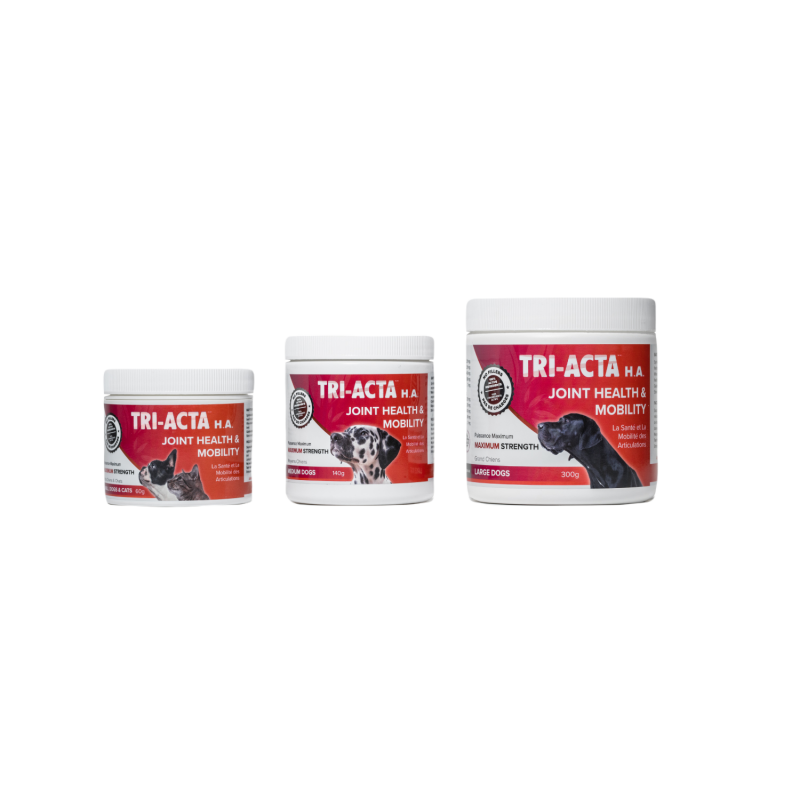
Health and Behavioural Benefits of Early Spaying
For cat lovers, a house full of kittens might be a dream come true; but in reality, taking care of litters of kittens isn’t ideal.
While preventing pregnancy and population control are the primary reasons for cat spay procedures, early cat spaying can increase your cat’s life expectancy and is an integral part of feline health.
There are several health and behavioural benefits of early spaying, including:
- Reducing the risk of reproductive diseases.
- Decreasing the risk of breast cancer.
- Eliminating the chance of uterine infections.
- Improving behaviour associated with mating.
During a cat spay surgery, the ovaries and uterus are removed, reducing the risk of reproductive diseases. It also prevents developing pyometra, a fatal uterine infection that occurs during hormonal changes, which make the uterus more susceptible to infections.
Removing the reproductive organs also reduces the risk of breast cancer, the primary cancer diagnosed in unspayed female cats.
Most cat owners appreciate the behavioural benefits offered by a cat spay surgery. By mitigating behaviour associated with mating, your cat is less likely to roam, rub her rear end against furniture, or engage in loud and persistent howling.
How Much to Spay a Cat? Understanding the Costs
Being a cat owner can be costly when you want the best care for your pet. While the cost to spay a cat is on the lower end of the spectrum when it comes to cat surgery, it can still cost you, in most cases, more than your cat herself.
Cost to Spay a Cat: What to Expect
To give a general idea of “how much is it to spay a cat?” The average cost of a cat spay in Canada is $200. Of course, this number can vary depending on the clinic, as well as any complications that may arise from the procedure. s
There are several factors affecting cat spay costs:
- Location
- Vet fees
- Cat’s health
- Vaccinations
- Subsidized rates
Cat spay surgeries cost more in Bigger cities like Vancouver and Toronto, as these surgeries are in higher demand and clinics may have newer and more innovative equipment compared to rural areas. Vet fees can also differ depending on the professional’s level of experience or the reputation of their practice.
Your cat’s health also plays a critical role in the cost to spay a cat, as they may need vaccinations or medication before surgery. Vets may order bloodwork and other medical tests before surgery, and cats who pose more of a risk might be subject to a higher surgery cost.
The grand total of your cat spay surgery may be decreased if subsidized rates are available, which some areas offer.
Low-Cost Cat Spay Options
Many municipal humane societies offer cat spay and neuter services at a discounted rate compared to private veterinary clinics. They may also offer additional discounts to qualifying individuals with a household income below a certain rate. Several non-profit programs also aim to provide families with low costs for cat spay surgeries.
To find low cost cat spay in your area, contact your local humane society for a list of resources available.
The Spaying Procedure: What Happens During Surgery?
As cat owners, we do everything to ensure the best for our felines in terms of cat health. However, the thought of a cat spay surgery can be daunting, and you might have doubts. Your beloved cat or kitten has likely not experienced a surgery, and you are unsure what to expect.
Preparing for Surgery
When choosing a veterinarian for your cat, be sure to choose one who is experienced and trusted with cat spay and neuter procedures. If surgeries are not their expertise, a good vet will have a trusted surgeon for cat spay and other surgeries. Veterinary surgeons will ensure you are well-prepared to care for your cat pre- and post-surgery.
Before a cat spay surgery, your vet will provide you with a list of pre-surgical instructions to follow. Pre-surgical instructions for a cat spay typically include:
- Fasting from food after 9 PM the night before surgery
- No water after 6 AM on the morning of the surgery
- Keeping your cat indoors the night before surgery
Prepare to bring your cat into the clinic first thing in the morning on the day of surgery. Be sure to keep your kitty contained in a pet carrier and pack their favourite blanket or towel for comfort. Your vet will administer pain medication to your cat before the surgery starts.
What Happens During a Cat Spay?
The cat spay surgery begins after the patient has been given pain medication and is under appropriate anesthesia.
What happens during a cat spay can be broken down into the following steps:
- Anesthesia: The Cat is placed under general anesthesia.
- Preparation: The Surgical site is shaved and sterilized.
- Incision: A Small incision is made in the middle of the abdomen.
- Removal of Organs: The vet locates and removes the ovaries and uterus.
- Closing the Incision: The incision is closed with sutures in multiple layers.
- Recovery: Cat is monitored until she wakes up from anesthesia and is discharged within 24 hours.
Cat spay and neuter surgeries share the same primary objective: to prevent unwanted pregnancies and reduce the population. Both surgeries also reduce behaviour associated with mating. There are, however, several differences between a cat spay a neuter.
Refer to the chart below for the difference between spay vs neuter cat surgeries.
|
Cat Spay |
Cat Neuter |
|
|
Cat Spay Recovery: Healing and Aftercare
Cat spay recovery usually takes 10-14 days. During this time, it is crucial to keep a close eye on your cat and restrict its exercise.
Immediate Post-Surgery Care
Like most surgeries for humans and animals, the first 24-48 hours are the toughest, especially for helpless animals who can’t communicate their discomfort.
During the first 24 hours of a cat spay recovery, be sure to do the following:
- Place your cat in a small, quiet area separate from other pets and small children.
- Offer small amounts of food and water (several hours post-surgery).
- Encourage light movements to help the anesthesia wear off.
- Keep the surgical area dry.
- Use an Elizabethan collar/ cone or a surgical onesie.
Monitoring for Bad Signs After Cat Spay
In the first few days following a cat spay surgery, it is critical to monitor for signs of infection. Redness and swelling are expected during the first 24-48 hours. You can use an ice pack wrapped in a towel over your pet’s incision to reduce inflammation while keeping the surgical site dry.
Check the incision site twice daily for the following signs of infection after a cat spay recovery:
- Bruising and swelling
- Increased redness
- Wound not healing
- Foul odour
- Discharge of pus or fluid
- Warm incision site
You may also notice behavioural changes indicating bad signs after cat spay surgery:
- Lethargy after the initial first days
- Overheating
- Shivering
- Aggressive behaviour when touched
- Being unable to get comfortable
If you notice any signs of infection or behavioural changes following cat spay surgery, you should book an appointment with your vet as soon as possible.
Long-Term Recovery Tips
Adequate post-operative care following a cat spay surgery is crucial to mitigate the chances of your cat needing additional medical care. Improper aftercare can result in the need for antibiotics, extra medication, or even a follow-up surgery.
In the first 14 days following a cat spay surgery, be sure to adhere to the following instructions:
- Restrict exercise and rough play.
- Confine the cat to a private area.
- Keep outdoor cats indoors.
- Do not bathe or allow swimming.
- Use an e-collar or surgical onesie if your cat is still licking or biting their incision.
- Switch to non-clumping or low-dust litter.
Restricting exercise and rough play is essential for proper healing of the surgical site. Try to discourage your cat from running, jumping, or playing with stimulating toys.
Keeping your cat confined to a private area away from other pets, young children, or busy activity is recommended, especially overnight or while you are out of the house.
Keeping your cat indoors during the two-week healing period is also necessary. When their surgical site is healed, gradually reintroduce outdoor time, as sometimes, healed incision sites might not be fully back to normal.
Avoid bathing your cat or allowing them to swim; it is important to keep the surgical incision site dry for 14 days. Use an e-collar or surgical onesie to prevent your pet from bathing themselves.
Some veterinarians also recommend switching to a non-clumping or low-dust litter, which is less likely to contaminate the surgical site.
Nutrition and Cat Supplements
After your cat has fully recovered, it is important to maintain healthy nutrition habits to ensure optimal cat health. While cat spay surgery may be essential for most kittens, we want to prevent the need for future surgeries and health concerns.
Talk to your veterinarian about choosing the best kitten food for the first year of their life, followed by healthy adult and senior cat food. Consider cat probiotics for intestinal health, and a cat joint supplement for the maintenance of healthy joints and cartilage. Pet supplements like TRI-ACTA aid with pain and inflammation and the rebuilding of cartilage, to protect joints as your kitten enters their adult years.
Cat Spay Surgery: A Necessary Component of Cat Health
Cat spay surgeries are a necessary component of cat health. Whether our goal is to prevent pregnancies and reduce population, or we are concerned about the risks associated with reproductive health, cat spay procedures have many benefits for cats and their owners.
As you navigate your journey as a cat owner, consider investing in top-quality nutrition and cat supplements for your cat. Choose an expert pet supplement supplier like Integricare to ensure the best quality supplements for pet health. TRI-ACTA products deliver pharmaceutical-grade active ingredients with no fillers.
TRI-ACTA can be used as proactive joint supplements for cats. TRI-ACTA H.A. contains added hyaluronic acid to support pets healing from surgery or injury, or cats entering their golden years.
TRI-ACTA for Pets
A proactive approach for developing and younger adult pets to maintain optimal joint health mobility, minimize inflammation and fend off age-related ailments.

Newsletter Signup
Subscribe to our newsletter to receive the latest news and exclusive offers.
.jpg?height=2000&name=Cliick_Integricare-DISPLAY-REVISEDV2%20(1).jpg)
Proactive & Therapeutic Joint Supplements
When given daily, Integricare joint supplements recover bone and joint injuries faster and help prevent mobility injuries from happening in the first place.

